WARMWATER FLY-FISHING AT NIGHT
Why Fly-Fish at Night?
For the last couple of years, I find I’ve been getting my fly-fishing and fish-catching fixes more and more often at night. I suppose there was something of a natural progression for me to gravitate towards this type of fishing. I’ve never been afraid of the challenge of fishing after dark. In fact, I’ve caught some nice fish, and often good numbers of fish, after the sun goes down. here are a number of good reasons to fly-fish at night.
First, what with spending quality time with my family, and transporting my kids to and from various extra-curricular activities and such, I find that if I'm going to get my "fishing fix" with any regularity, I either need to go during my lunch hour (which I often do), or I can go after my family is "down for the evening" (or both!)
Second, it is very peaceful at night, since most of the time, wind velocities have calmed down enough that it doesn’t adversely affect casting or strike detection.
Third, you (or you and your fishing partner(s)) will nearly always have the water all to yourself! This is especially wonderful if you are a beginning fly angler, and you don’t yet cast like Lefty Kreh! There’s nobody around to chuckle annoyingly while you untangle the line from around your rod, retrieve a hook that has gotten caught up in the grass or brush behind you, or remove the fly hook out of the back of your cap. Since I usually fish alone, there’s no proof that any of this has ever happened to me, of course.
Fourth, think of it as a way to hone your casting skills. If you like to watch your line while you cast during the daytime, fly-casting at night will cure you of that affliction! I think it helps you improve your FEEL for casting, rather than worrying about what shape your “loop” is behind you. Then again, I am NOT an expert caster, so maybe I really SHOULD worry about these things?
Fifth, many of the small public waters I fish get substantial fishing pressure. Some still have good fishing during the day, but most have MUCH better fishing after dark! I find this especially true for crappies and bluegills, and to a certain degree this holds true for catfish as well. It also seems like the bigger bass are either more willing to hit at night, or maybe they are simply more susceptible to the top water or shallow presentations I enjoy using at night.
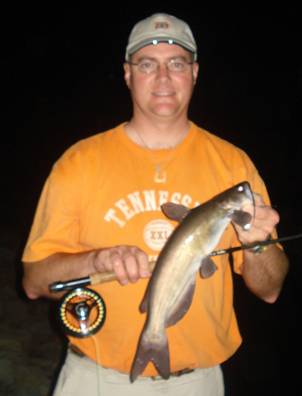
So, how does one go about the business of fly-fishing at night?
I am fortunate in that many of the small public ponds I fish are in relatively new parks (10 years old), and the landscaping is well-manicured lawns, with few or no large trees near the water’s edge. So, I can cast (flail) with abandon, without much worry about snagging up in a tree at night.
If the waters you fish are surrounded by trees, brush and high grass, I recommend you get yourself away from the shoreline. You can fly-fish lakes from a boat at night. If you don’t have a boat, but are comfortable with your knowledge of your local waters, you can certainly also wade-fish at night. This can be very exciting!
I have not yet tried fly-fishing the local rivers after dark. I hope some of you can post such reports, as I would enjoy learning more about this.
Equipment
I operate under the premise that I can find fish in the shallows at night during most of the open-water season, or suspended over deeper water within casting distance, so I use WF Floating line. Regardless of my target species, I use either top water flies, or lightly weighted streamers, nymphs or wet flies. There aren’t many submerged rocks or wood structure in the waters I fish, but getting snagged up at night isn’t fun, so I have so far avoided heavily weighted flies. This doesn’t mean they wouldn’t be effective, however.
For leaders, you can get away with heavier line at night, because I don’t think the fish can see it as well as they might during the daytime. So, I often use anything from 0X-3X leaders, and I find 2X to be about perfect for much of the fishing I do.
Mobility is often important for night fishing, so I travel as light as I can. I think most fly anglers do this anyway, so this shouldn’t be a big change for most. You can use chest packs, fly vests, or fanny packs. Or you may even be able to fit everything you need in the pockets of your pants.
I like to take an inexpensive digital camera, a tape measure, forceps or needle-nose pliers, one or two boxes of flies, and extra leader/tippet material, extra Fas-Snaps. I pack it all in a big fly-fishing fanny pack. I swivel the fanny pack so the big storage pouch (es) are at my back. This helps prevent the fly line from tangling in it while casting or retrieving. If I need something out of it, I simply spin it back around to the front or side.
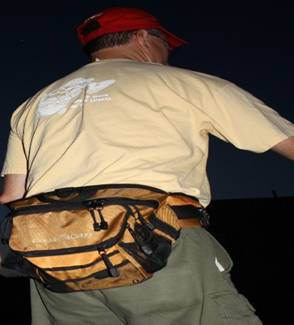
Here’s a photo of the fanny pack I use:
As you may suspect, the most important item to have while fly-fishing at night is….LIGHT. I’ve got a cap that has 2 LED bulbs built into the bill of the cap. The batteries are changeable, but the original batteries have lasted me ALL YEAR! The one I use is made by Panther Vision. It looks like this:
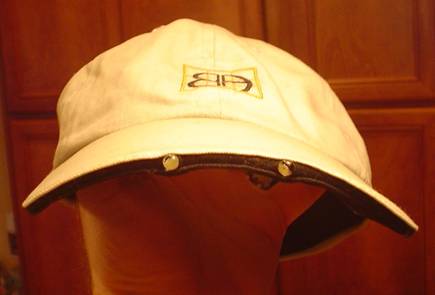
On occasion, I also use the LED cap lights you can buy from almost anywhere, the kind that clips to the underside of your cap bill. They look like this:
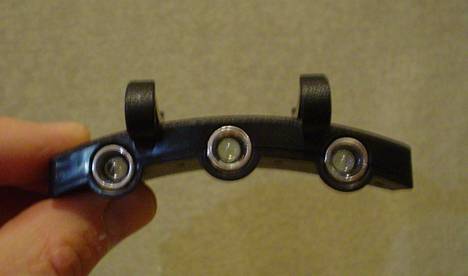
Mosquitoes or other nocturnal bugs can sometimes be “pesky”. Although I’ve had occasions over the years when mosquitoes have overwhelmed me, usually they don’t bother me excessively. Knock on wood. he worst thing is usually if they are flying around in my face. I combat these by smoking a cigar while I fish, at least early in the evening. Later on, the bugs seem to give up. I’m not suggesting everyone take up cigar smoking. If you’d rather douse yourselves in a bug repellent of your choice, have at it.
Fishing
I usually start by casting parallel to shore. If the fish are there, this is often the quickest place to find actively feeding fish. If not, I fan cast the area, gradually working out to deeper water. If the fish are there, fine. If not, I walk about half the length of my casts down the shoreline, and start my pattern of casting again. Fish may be scattered. You may pick up one over deeper water, and a couple near shore, and then not get any more hits. You can try switching flies, if you are confident more fish are in the area. Otherwise - MOVE. Cover the water and pick up the aggressive fish.
I retrieve fairly slowly, usually about 3” medium-paced strips, with the movement almost constant. I believe a slow but steady retrieve helps the fish locate and track the movement of the fly as they make their approach to strike.
Fly selection
I’m certain fish can see better at night than I can, but I also think they make good use of their lateral line at night. Because of this, the important points to remember when selecting a fly for night fishing are:
-Fish flies that push some water, or have hackle that sends off vibrations as the fly is moved.
-Fish flies of the appropriate size for the fish that are in the pond that you are targeting.
-Fish slow enough that the fish can spot and take the fly without working too hard.
-I really like using flies with de-barbed hooks at night. I can often free the fish back into the water without even touching the fish. Slime-free hands are warmer hands, when the nights get cooler. (I credit Rick Zeiger for encouraging me to try barbless hooks. Thanks Rick!)
You can try different colors of flies. I've had success with yellow, orange, silver/gray, brown, purple, or white flies. I’ve heard black is a good color at night too, but haven’t tried it yet. The purple woolly buggers or brown dragonfly nymphs I’ve used at night probably look black in the dark.
Strike Detection
While sometimes I feel the strike before seeing it, most of the time strike detection is a visual thing. The floating fly line I use is sort of that pale green color that is very common. I find that on most nights I can see it well enough to detect strikes without turning on my cap light.
Warm water Fish Species
Bluegills hit fairly good after dark, but probably hit best around dusk. In my experience, crappies seem to hit BEST at night at the ponds I fish. Top water flies, such as a small foam popper or Gurgler, are excellent nighttime flies for bluegills. For subsurface approaches, boa yarn leeches, mohair leeches, woolly buggers, and dragonfly nymphs have worked really well for me.
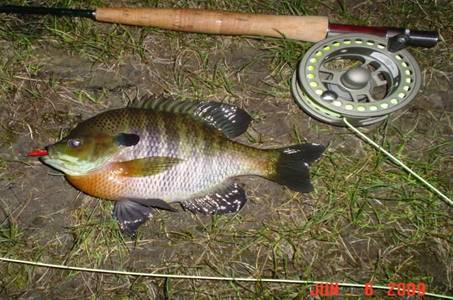
Crappies tend to stay deep and away from shore during the day, but move higher in the water column and closer to shore at night. Boa yarn leeches have been my top producer for crappies at night this past year. They are bulky enough to push water, light
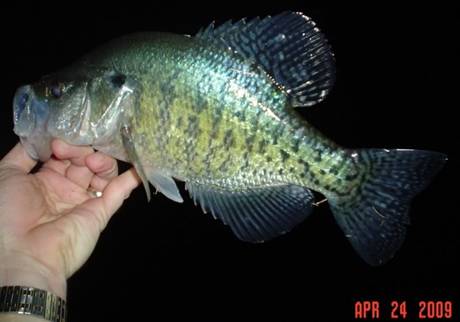
Largemouth Bass will hit at night. Sometimes a loud foam popper like a Gurgler or Crease Flies will work best at getting their attention after dark. Work it like a frog...a couple short pops, then let it set for awhile - repeat.
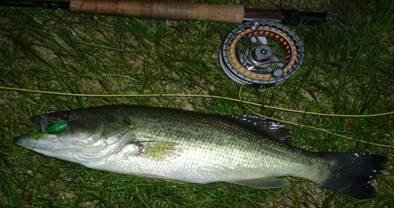
Channel Catfish will hit surface flies the same as the bass will, and will also take the subsurface flies I use for bluegills and crappies (generally flies tied on #8 nymph or streamer hooks).
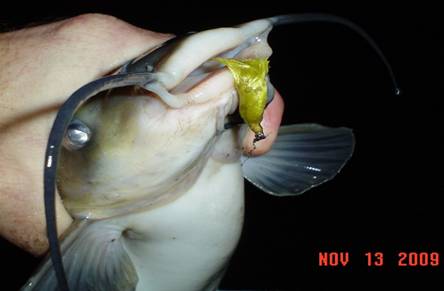
I’m sure there are other warm water species one could target at night. The variety isn’t large on the waters I usually fish. And it’s always a big thrill when you catch something unexpected.
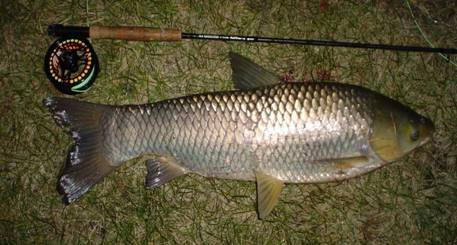 a
a
So, if you want to have fun catching fish on flies, have the water all to yourself, and extend your fishing time without giving up important “family time”, give nighttime fly-fishing a try!
